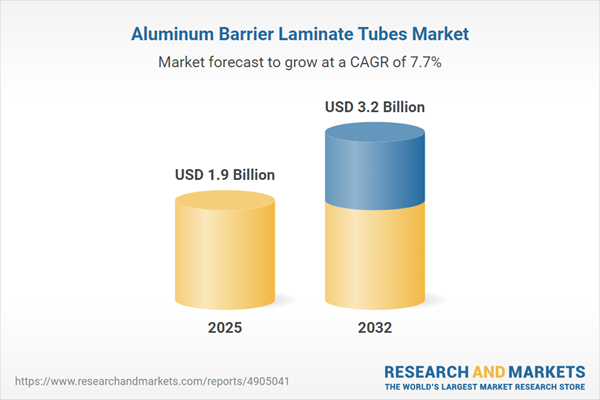Speak directly to the analyst to clarify any post sales queries you may have.
Aluminum barrier laminate tubes are redefining standards for packaging performance and reliability, offering advanced protection and design flexibility across critical applications. With robust barriers against moisture, oxygen, and light, these tubes are enabling innovation and efficiency for manufacturers aiming to deliver quality and compliance in consumer and industrial sectors.
Market Snapshot: Aluminum Barrier Laminate Tubes Market
The Aluminum Barrier Laminate Tubes Market grew from USD 1.76 billion in 2024 to USD 1.90 billion in 2025. It is expected to continue growing at a CAGR of 7.73%, ultimately reaching USD 3.20 billion by 2032. This growth reflects both rising adoption across categories and intensifying innovation in tube construction, sustainability, and supply chain integration.
Scope & Segmentation: Insights Across the Value Chain
- Applications: Adhesives & Sealants, Cosmetics & Personal Care, Food & Beverage, Pharmaceuticals
- Layer Count: Five-Ply, Seven-Ply, Three-Ply
- Tube Diameter: 31 to 50 Millimeters, Above 50 Millimeters, Up to 30 Millimeters
- Decoration Types: Labelled, Plain, Printed, Sleeved
- Closure Types: Disc Top Cap, Flip Top Cap, Screw Cap
- Regional Coverage: Americas (North America, Latin America), Europe, Middle East & Africa, Asia-Pacific
- Key Companies Profiled: Amcor plc, Tetra Pak International S.A., Berry Global Group, Inc., Essel Propack Limited, Huhtamäki Oyj, Pact Group Holdings Limited, GualaPack S.p.A., Albea S.A., TEXEN S.A.S., CCL Industries Inc.
Key Takeaways: Strategic Considerations in the Aluminum Barrier Laminate Tubes Market
- Packaging manufacturers are intensifying R&D in lamination and digital printing to deliver market-driven innovation and compliance.
- Segment-specific tube designs address demands such as precision dispensing in adhesives, premium aesthetics for cosmetics, and product stability for pharmaceuticals.
- Sustainability is now integral, driving new formulations focused on recyclability, bio-based materials, and circular economy alignment.
- Personalized decoration capabilities are reshaping brand differentiation, especially in competitive sectors like personal care and nutraceuticals.
- Real-time analytics and agile supply chains are critical, allowing companies to pivot production and sourcing strategies in response to market fluctuations or regulatory changes.
Tariff Impact: Navigating Cost and Supply Chain Pressures
Recent tariff measures in the United States have prompted significant adjustments across aluminum barrier laminate tube supply networks. Producers are actively diversifying supplier bases and increasing local production to reduce tariff exposure. This has led to collaborative process improvements focused on material efficiency, as well as investments in scenario-based tariff planning for enhanced operational resilience.
Methodology & Data Sources
This report is grounded in a robust methodology blending primary interviews with packaging experts and industry executives alongside secondary research of industry publications, trade databases, and regulatory documents. Rigorous validation through data triangulation and expert review supports the credibility of market insights presented here.
Why This Report Matters
- Facilitates better capital allocation by detailing segment-level trends, innovation pipelines, and regional demand patterns.
- Enables stakeholder confidence by tracking the latest sustainability practices, compliance requirements, and tariff implications.
- Supports strategic planning with data-driven analysis of supply chain optimization and emerging opportunity areas across end-use industries.
Conclusion
The aluminum barrier laminate tubes market is evolving through advancements in technology, sustainability, and strategic supply chain adaptations. This report equips senior decision-makers with the granular insights needed to navigate complexity and seize growth opportunities with confidence.
Additional Product Information:
- Purchase of this report includes 1 year online access with quarterly updates.
- This report can be updated on request. Please contact our Customer Experience team using the Ask a Question widget on our website.
Table of Contents
3. Executive Summary
4. Market Overview
7. Cumulative Impact of Artificial Intelligence 2025
Companies Mentioned
The companies profiled in this Aluminum Barrier Laminate Tubes market report include:- Amcor plc
- Tetra Pak International S.A.
- Berry Global Group, Inc.
- Essel Propack Limited
- Huhtamäki Oyj
- Pact Group Holdings Limited
- GualaPack S.p.A.
- Albea S.A.
- TEXEN S.A.S.
- CCL Industries Inc.
Table Information
| Report Attribute | Details |
|---|---|
| No. of Pages | 180 |
| Published | November 2025 |
| Forecast Period | 2025 - 2032 |
| Estimated Market Value ( USD | $ 1.9 Billion |
| Forecasted Market Value ( USD | $ 3.2 Billion |
| Compound Annual Growth Rate | 7.7% |
| Regions Covered | Global |
| No. of Companies Mentioned | 11 |









